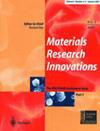Enhanced structural properties of electrochemically synthesised NiFeS using 500 keV carbon C ++ ions irradiation
Q2 Engineering
引用次数: 0
Abstract
ABSTRACTAn electrochemical approach was used to synthesise nickel iron sulphide (NiFeS) materials in this work. The prepared NiFeS underwent a thorough investigation, which included analyses of its optical, electrical, structural, morphological, elemental, and functional group properties. Cubic crystal formations with prominent peaks were visible from the structural pattern. Nanoflakes and pebbles were visible, and their elements were determined through elemental dispersive X-ray diffractometer (EDX) spectrum. The film’s crystallinity increased after incorporating carbon ions and its optical properties improved, with energy band gap values ranging from 1.50 eV to 1.15 eV as the peaks became more distinct. The materials produced could be utilised in the production of solar cells and optoelectronic devices. The electrical conductivity diminishes with increasing thickness. Carbon ion radiation increases carrier concentration, which increases electrical conductivity.Research highlightsNiFeS was irradiated using 500 keV carbon C++ ions beam irradiationNiFeS without irradiation has a bandgap of 1.50 eV, while the irradiated material had bandgaps between 1.35-1.15 eV.The film’s crystallinity was enhanced by incorporating carbon ionsNanogels and nanoflakes were seen in the micrographs of the unirradiated materials.KEYWORDS: NickelNiFeSions beamcarbonenergy bandgapirradiation Disclosure statementThe authors affirm no financial or interpersonal conflicts affected the research in this study.Data availability statementData can be given upon request.Authors’ credit statementIjabor Okeoghene Blessing, Haneef Shah, Imosobomeh L. Ikhioya: Conceptualisation, Methodology, Original Draft Writing, Imosobomeh L. Ikhioya and Shahbaz Afzal: software, and editing. Imosobomeh L. Ikhioya: Investigation and visualisation.500 keV碳++离子辐照增强电化学合成NiFeS的结构性能
摘要采用电化学方法合成了硫化铁镍(NiFeS)材料。对制备的NiFeS进行了全面的研究,包括对其光学、电学、结构、形态、元素和官能团性质的分析。从结构图中可以看到具有突出峰的立方晶体结构。纳米薄片和鹅卵石可见,并通过元素色散x射线衍射(EDX)光谱测定其元素。加入碳离子后,薄膜的结晶度提高,光学性能得到改善,能带隙值在1.50 ~ 1.15 eV之间,峰更加明显。所生产的材料可用于生产太阳能电池和光电子器件。电导率随厚度的增加而降低。碳离子辐射增加载流子浓度,从而增加电导率。采用500 keV的碳C++离子束辐照snifes,未辐照的nifes带隙为1.50 eV,而辐照后的材料带隙为1.35 ~ 1.15 eV。在未辐照材料的显微照片中可以看到纳米凝胶和纳米薄片。关键词:镍离子束碳能带辐照披露声明作者确认本研究中没有经济或人际冲突影响研究。数据可用性声明可应要求提供数据。作者致谢:tijabor Okeoghene Blessing, Haneef Shah, Imosobomeh L. Ikhioya:概念化,方法论,原始草稿写作,Imosobomeh L. Ikhioya和Shahbaz Afzal:软件和编辑。Imosobomeh L. Ikhioya:调查和可视化。
本文章由计算机程序翻译,如有差异,请以英文原文为准。
求助全文
约1分钟内获得全文
求助全文
来源期刊

Materials Research Innovations
工程技术-材料科学:综合
CiteScore
5.20
自引率
0.00%
发文量
38
审稿时长
2.8 months
期刊介绍:
Materials Research Innovations covers all areas of materials research with a particular interest in synthesis, processing, and properties from the nanoscale to the microscale to the bulk. Coverage includes all classes of material – ceramics, metals, and polymers; semiconductors and other functional materials; organic and inorganic materials – alone or in combination as composites. Innovation in composition and processing to impart special properties to bulk materials and coatings, and for innovative applications in technology, represents a strong focus. The journal attempts to balance enduring themes of science and engineering with the innovation provided by such areas of research activity.
 求助内容:
求助内容: 应助结果提醒方式:
应助结果提醒方式:


